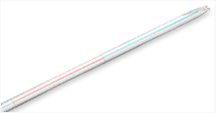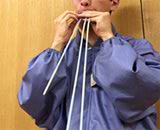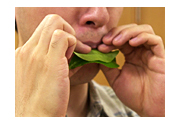The Structure of the Oboe
[Experiment]Try making a reed out of a straw
Straw reed experiment
In this experiment, a reed is made using a juice straw, and the sound is compared to that produced by an ordinary reed.
Experiment steps
- Cut a triangle out of the end of a straw.
- Fasten the straw reed to the tube.
- Stick the tube into the oboe and try playing.
- Compare the sound to that produced with normal reeds.

Experiment results
With a straw reed
With normal reeds
Note: As this was an experiment, the recorded pitches differed from the correct notes.
The straw reed will make a sound when placed into the mouth and blown through with force. Even a beginner can make a noise with ease. However, in the experiment, no sound is produced when the triangle-cut base of the reed is flattened. Therefore, the player corrects the shape of the straw inside the mouth to make the cut surfaces round while blowing into them. If the straw is not inserted into the mouth at just the right depth, it will be utterly impossible to control the instrument's tones to keep them stable.
Try making a straw instrument
In this experiment, the lengths of straws are adjusted to make reeds, which are played like instruments.
Experiment steps
- Assemble several straws of the same thickness.
- Make triangular cuts in the ends of the straws.
- Use cellophane tape to fasten multiple straws together to make instruments of lengths 100 cm, 80 cm, 67 cm, and 50 cm.
- Try playing the straws.

Experiment results
The sound of a straw instrument with a diameter of 6 mm

-
100 cm
-
80 cm
-
67 cm
-
50 cm
The sound of a straw instrument with a diameter of 5 mm
100 cm+80 cm+67 cm

Note: As this was an experiment, the recorded pitches differed from the correct notes.
These lengths, 100, 80, 67, and 50, represent the ratios of pipe lengths that produce the notes C, E, G, and C#, respectively. When the instruments are made with straws with diameters of 6 mm, the actual pitches that are heard are E♭, G, B♭, and E♭.
If the straw is touched with a finger while it is being played, the upper portion will shake, clearly showing that the tube is vibrating all the way to the tip. The narrower the diameter of the straw, the greater the resistance, requiring more forceful blowing. Conversely, the wider the diameter, the easier it is to blow into the straw, but all the breath is used up quickly, so the straw cannot be played for a long time with one breath.
Bonus experiment
Align two leaves with one another and place them lightly between pursed lips. When breath is blown between the two leaves, a sound is produced in accordance with the double-reed principle. It is ideal if the ends of the leaves are slightly bent and there is a small passageway for air in the middle. It would be interesting to try a variety of different sorts of leaves, such as tea leaves, persimmon leaves, and hydrangea leaves.

Musical Instrument Guide:Oboe Contents
Structure
How to Play
How the Instrument is Made
Choosing an Instrument
Trivia
- Why does the oboe lead the orchestra in tuning?
- Do the reeds have a front and a back?
- The keys recoil via springs!
- This is how the oboe and the cor anglais differ
- The charumera was the oboe's cousin
- You can reduce time spent breathing using circular-breathing techniques?
- The Wiener oboe that survived an existential crisis
- Oboe masterpieces: concertos
- Oboe masterpieces: chamber music
- What is the alto oboe?
- The heckelphone, which resembles the oboe
- The oboe is the bassoon's cousin
